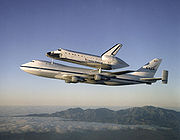Aeronautics

Aeronautics (from Greek ὰήρ āēr which means "air" and ναυτική nautikē which means "navigation, seamanship", i.e. "navigation of the air") is the science involved with the study, design, and manufacture of flight-capable machines, or the techniques of operating aircraft. While the term—literally meaning "sailing the air"—originally referred solely to the science of operating the aircraft, it has since been expanded to include technology, business and other aspects related to aircraft.[1]
One of the significant parts in aeronautics is a branch of physical science called aerodynamics, which deals with the motion of air and the way that it interacts with objects in motion, such as an aircraft. Aviation is a term sometimes used interchangeably with aeronautics, although "aeronautics" includes lighter-than-air craft such as airships, while "aviation" does not.[1]
Contents |
Early aeronautics

The first mention of aeronautics in history was in the writings of ancient Egyptians who described the flight of birds. It also finds mention in ancient China where people were flying kites thousands of years ago. The medieval Islamic scientists were not far behind, as they understood the actual mechanism of bird flight. Before scientific investigation of aeronautics started, people started thinking of ways to fly. In a Greek legend, Icarus and his father Daedalus built wings of feathers and wax and flew out of a prison. Icarus flew too close to the sun, the wax melted, and he fell in the sea and drowned. When people started to scientifically study how to fly, people began to understand the basics of air and aerodynamics. Ibn Firnas may have tried to fly in 8th century in Cordoba, Al-Andalus.[2]
Roger Bacon and Leonardo da Vinci were some of the first modern Europeans to study aeronautics. Leonardo studied the flight of birds in developing engineering schematics for some of the earliest flying machines in the late fifteenth century AD. His schematics, however, such as the ornithopter ultimately failed as practical aircraft. The flapping machines that he designed were either too small to generate sufficient lift, or too heavy for a human to operate.
Although the ornithopter continues to be of interest to hobbyists, it was replaced by the glider in the 19th century. Sir George Cayley was one of the most important people in the history of aeronautics. Many consider him the first true scientific aerial investigator and the first person to understand the underlying principles and forces of flight.[3] A pioneer of aeronautical engineering,[4] he is credited as the first person to separate the forces of lift and drag which are in effect on any flight vehicle,[5]
Francesco Lana de Terzi, a 17th Century Jesuit professor of physics and mathematics from Brescia, Lombardy, has been referred to as the Father of Aeronautics.[6] In his work Prodromo dell'Arte Maestra (1670) he proposes a lighter-than-air vessel based on logical deductions from previous work ranging from Archimedes and Euclid to his contemporaries Robert Boyle and Otto von Guericke.
See also


- Aerodynamics
- Aeronautical abbreviations
- Aerospace engineering
- Aerostat
- Aileron
- Air safety
- Aircraft
- Aircraft design
- Aircraft flight control system
- Aircraft flight mechanics
- American Institute of Aeronautics and Astronautics
- Astronautics
- Aviation
- Aviation, aerospace, and aeronautical terms
- Avionics
- Center of gravity of an aircraft
- Flaps
- Flight control surfaces
- Flight Dynamics
- Hydrodynamics
- Hydrostatics
- Kite types
- Longitudinal static stability
- Mechanics of fluids
- Shirt-sleeve environment
- Spacecraft
- The Royal Aeronautical Society
- Wing
References
- ↑ 1.0 1.1 "Aeronautics". Encyclopedia Americana. 1. Grolier. 1986. pp. 226.
- ↑ First Flights, Saudi Aramco World, January-February 1964, p. 8-9.
- ↑ "Sir George Carley". Flyingmachines.org. http://www.flyingmachines.org/cayl.html. Retrieved 2009-07-26. "Sir George Cayley is one of the most important people in the history of aeronautics. Many consider him the first true scientific aerial investigator and the first person to understand the underlying principles and forces of flight."
- ↑ "Sir George Carley (British Inventor and Scientist)". Britannica. http://www.britannica.com/EBchecked/topic/100795/Sir-George-Cayley-6th-Baronet. Retrieved 2009-07-26. "English pioneer of aerial navigation and aeronautical engineering and designer of the first successful glider to carry a human being aloft."
- ↑ "The Pioneers: Aviation and Airmodelling". http://www.ctie.monash.edu.au/hargrave/cayley.html. Retrieved 2009-07-26. "Sir George Cayley, is sometimes called the 'Father of Aviation'. A pioneer in his field, he is credited with the first major breakthrough in heavier-than-air flight. He was the first to identify the four aerodynamic forces of flight - weight, lift, drag, and thrust - and their relationship and also the first to build a successful human carrying glider."
- ↑ "Francesco Lana-Terzi, S.J. (1631-1687); The Father of Aeronautics". http://www.faculty.fairfield.edu/jmac/sj/scientists/lana.htm. Retrieved 01 May 2010.
External links
- Aeronautics History in Turkey
- Aeronautics History - Charles Vivian - 1920 (eLibrary Project - eLib full text)
- Aerospace courses at MIT OpenCourseWare
- American Academy of Aeronautics aeronautical science
- American Helicopter Society
- American Institute of Aeronautics and Astronautics
- Examples of Aeronautic Designs
- What is aeronautics? The history of world Aeronautics (Russian)
- Aircraft Design: Synthesis and Analysis
- ACARE Taxonomy
- CREating innovative Air transport Technologies for Europe